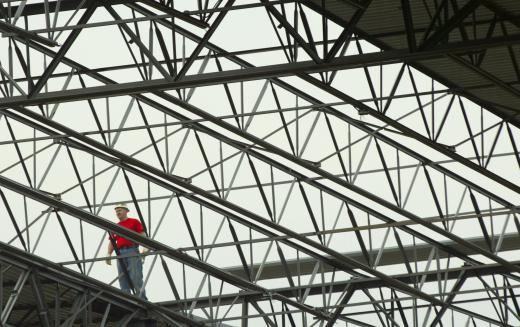Rafter ties keep opposing rafters tied together to increase the strength of roof trusses. Two types of rafter ties — wood and metal — are common to residential and light commercial construction. Wooden rafter ties cross the span between two opposing rafters, mechanically tying the rafters together. Metal rafter ties provide a structural connecting point between the bottom of a single rafter and the supporting wall. The type of rafter tie required for roof trusses varies depending on the height and style of the finished interior ceiling.
Full-spanning wooden rafter ties run flat between the two sides of an installed roof truss. The bottom of the rafter tie sits on top of the walls supporting the rafters. This limits the interior ceiling height to the height of the walls supporting the rafters and allows for only flat or shallow tray ceilings. Metal rafter ties are required when the interior ceiling structure is a vault, cathedral or a half-story that requires headroom while leaving an open area for walking.

Metal rafter ties are made of galvanized metal and contain stamped holes that allow an installer to run nails through the tie and the rafter and wall. A twist at the midpoint of the tie allows it to sit flat against both the side of the rafter and the wall stud. The galvanized coating protects the base metal of the rafter tie from corrosion. Excessive corrosion weakens the structural integrity of the rafter tie. This will cause the tie to fail over time and will create a weak point in the installed rafters.
Reducing rafter weak points requires a second type of tie that strengthens the roof against uplift created by strong winds pushing against one or both sides of a finished roof. Like a rafter tie, rafter collar ties are made of either wood or metal and tie two rafters together. Unlike rafter ties, the majority of local building codes do not require collar ties as a mandatory rafter support. Installing collar ties on rafters is good practice in areas where high winds from hurricanes or gale force winds blow frequently.
Inspecting rafter ties every few years will allow rotted or corroded rafter ties to be found before a structural failure takes place. When a damaged rafter tie is located, immediately installing a second tie on the opposite side of the rafters before removing the damaged tie will keep rafters in place during the repair. This avoids a potentially dangerous situation for people living or working below the installed rafters.
